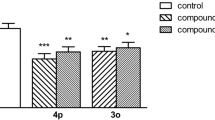A compound with low toxicity and pronounced antidepressant activity upon single and long-term administration was discovered by us earlier among a series of new thietanylxanthine derivatives. The present article focused on the central mechanisms of action of 2-[3-methyl-7-(thietan-3-yl)-1-ethylxanth-7-ylthio]acetic acid hydrazide (laboratory code M-20). Neuropharmacological analysis showed that M-20 at doses of 0.97 and 12 mg/kg exhibited effects indicative of possible stimulatory action on adrenergic and inhibitory action on GABA-ergic neurotransmission in brains of outbred white mice. M-20 at a dose of 12 mg/kg produced an activating effect on the serotoninergic system in addition to action on the adrenergic and GABA-ergic systems and altered the activity of the cholinergic system. M-20 at doses of 0.97 and 12 mg/kg did not alter the effects of haloperidol and L-DOPA, which indicated that it did not influence dopaminergic neurotransmission and MAO-inhibiting activity. The results indicated that M-20 was promising (at the low dose) for use with depression associated with decreased activity of the serotoninergic system without side effects on the dopaminergic and cholinergic systems.





Similar content being viewed by others
References
V. A. Golovacheva and V. A. Parfenov, Med. Sovet, No. 5, 55 – 60 (2015); doi: https://doi.org/10.21518/2079-701X-2015-5-55-61.
Depression and Other Common Mental Disorders; Global Health Estimates, World Health Organization, Geneva (2017).
K. S. Raevskii, Psikhiatr. Psikhofarmakoter., 3(5), 162 – 166 (2001).
L. A. Levchuk, S. A. Ivanova, E. V. Gutkevich, et al., Sib. Vestn. Psikhiatr. Narkol., 69(6), 13 – 16 (2011).
N. L. Shimanovskii, M. A. Epinetov, and M. Ya. Mel?nikov, Molecular and Nanopharmacology [in Russian], Fizmatlit, Moscow (2009).
G. G. Davlyatova and L. A. Valeeva, Zdorov. Obraz. XXI Veke, 18(7), 132 – 135 (2016).
L. A. Valeeva, G. G. Davlyatova, Yu. V. Shabalina, et al., Khim.-farm. Zh., 50(6), 8 – 11 (2016); doi: https://doi.org/10.30906/0023-1134-2016-50-6-8-11.
F. A. Khaliullin, I. L. Nikitina, E. E. Klen, et al., Khim.-farm. Zh., 53(12), 8 – 15 (2019); doi: https://doi.org/10.30906/0023-1134-2019-53-12-8-15.
Yu. V. Shabalina, F. A. Khaliullin, I. L. Nikitina, et al., Khim.-farm. Zh., 53(11), 21 – 24 (2019); doi: https://doi.org/10.30906/0023-1134-2019-53-11-21-24.
D. Z. Murataev, Yu. V. Shabalina, and F. A. Khaliullin, Bashkir. Khim. Zh., 19(1), 220 – 222 (2012).
A. N. Mironov, Handbook for Preclinical Drug Trials [in Russian], Grif i K, Moscow (2012).
R. U. Khabriev, Handbook for Experimental (Preclinical) Studies of New Drugs [in Russian], Meditsina, Moscow (2005).
S. Glantz, Primer of Biostatistics, 4th Ed., McGraw-Hill Inc., New York (1997), 473 pp.
A. Bielenica, E. Kedzierska, M. Kolinski, et al., Eur. J. Med. Chem., 116, 173 – 186 (2016); doi: https://doi.org/10.1016/j.ejmech.2016.03.073.
J. Arnt, J. Hyttel, and J. J. Larsen, Acta Pharmacol. Toxicol., 55(5), 363 – 372 (1984); doi: https://doi.org/10.1111/j.1600-0773.1984.tb01996.x.
F. García-Oscos, O. Torres-Ramírez, L. Dinh, et al., Synapse, 69(3), 115 – 127 (2015); https://doi.org/10.1002/syn.21794.
S. Koyama, C. Kubo, J.-S. Rhee, et al., J. Physiol., 518(2), 525 – 538 (1999); doi: https://doi.org/10.1111/j.1469-7793.1999.0525p.x.
A. O. Korolev, T. S. Kalinina, A. V. Volkova, et al., Eksp. Klin. Farmakol., 77(16), 3 – 7 (2014).
Author information
Authors and Affiliations
Corresponding author
Additional information
Translated from Khimiko-Farmatsevticheskii Zhurnal, Vol. 54, No. 5, pp. 7 – 10, May, 2020.
Rights and permissions
About this article
Cite this article
Valeeva, L.A., Davlyatova, G.G. & Shimanovskii, N.L. Neuropharmacological Analysis of the Antidepressant Action of 2-[3-Methyl-7-(Thietan-3-Yl)-1-Ethylxanth-8-YLTHIO] Acetic Acid Hydrazide. Pharm Chem J 54, 435–438 (2020). https://doi.org/10.1007/s11094-020-02218-7
Received:
Published:
Issue Date:
DOI: https://doi.org/10.1007/s11094-020-02218-7



